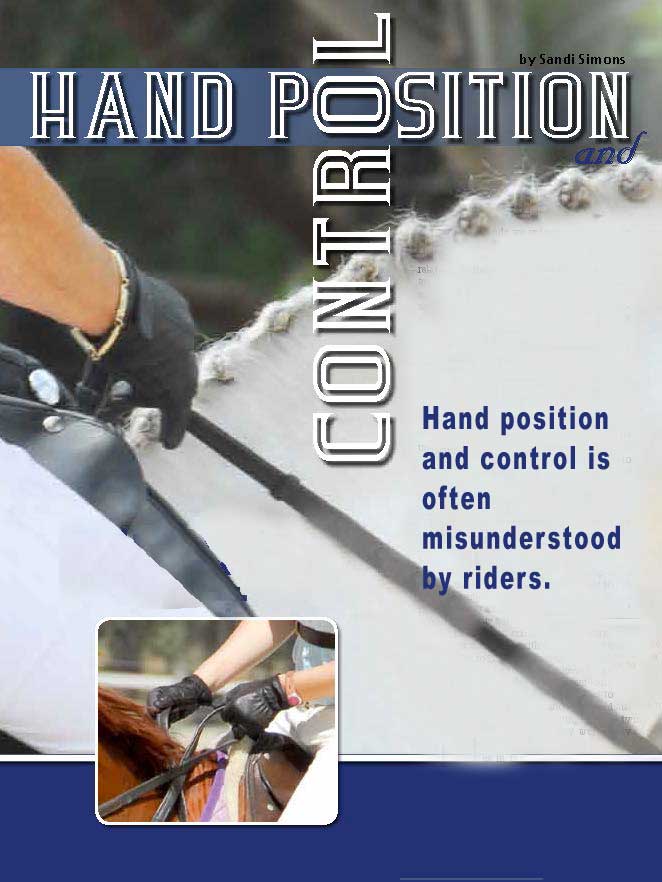
Human hands are unique and the way in which they are used is diverse. Apart from humans’ genetically closest relatives in the ape family, there are no other animals that have - or indeed use - these wonderful attachments on the end of the arms as much as humans do! Hands help with day-to-day tasks, expression of feelings and emotions and can become tools of a trade as well.
The use of hands is no less important and has no less meaning and influence on riding than they do in every day life. They are used as a means of communication with the horse, and the subtlety and control with which they are used can have a direct or indirect interaction.
The rider’s hands communicate to the horse via the reins and the bit in its mouth. The understanding and subsequent practice of hand position and control is essential if the rider is to achieve a balanced and harmonious partnership with the horse and progress in training - no matter what the particular discipline or area of equestrian activity.
Perhaps the importance of this would be easier to understand if riders were to consider what it would feel like to have a bit in their mouth with someone on the other end of the reins trying to get them to turn left, right, stop or go backwards. It’s fairly obvious that they would want the person on the other end of the reins to be as gentle as possible but be giving clear and consistent cues so it was clear what was being asked, thus avoiding confusion and disharmony. If the rider was rough with their hands or hung on to the bit to balance themselves the reaction would probably be to behave like some of the horses seen in pictures or at shows – mouth open, eyes wide, a rider balancing their body and weight on their mount’s mouth with hands held high, hauling around trying to steady themselves in the saddle. If they were lucky enough to have a rider with soft, sympathetic hands, who rode in a balanced and independent frame, they would probably look happy and content with their work.
Beginner riders generally either over or under use their hands until they are able to develop a sense of balance and control of their body. They often have very short reins and can be very insensitive to the horse, or else have no rein contact whatsoever and therefore give no guidance or support to the horse. Riders who are not confident may also have very short reins and hang onto the horse’s mouth. Sadly there are many more experienced riders who believe that they can pull a horse into a frame by using their reins to achieve the ‘desired’ head and neck position, giving the illusion of being on the bit. Nothing could be further from the truth however, and the long-suffering horses are forced to endure untold conflict and pain whilst being asked to perform.
When a rider picks up the reins it becomes a direct form of communication with the horse via the bit in its mouth. Hands can block the forward energy of the horse and guide it in a certain direction - left or right, halt and even ask it to go backwards. The use of the hands, in combination with the legs, is directly attributable to collection, impulsion, rhythm and speed. Incorrect use of the hands can cause a horse to lean on the bit and feel heavy in the hand and on the forehand. They can also cause the horse to hold its head too high, therefore evading contact and travelling in a hollow and evasive manner, or they can cause the horse to over bend and go behind the vertical, avoiding the rein contact.
Positioning and Using Hands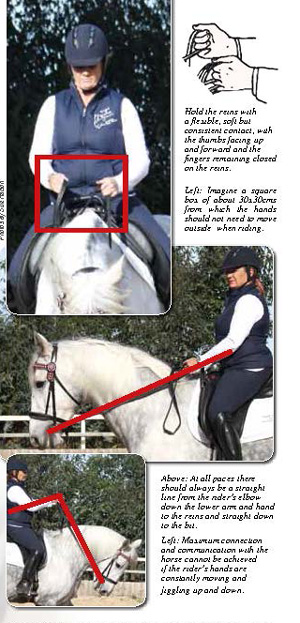
With the horse standing relaxed and square, imagine there is a straight line from the rider’s elbow (which should be resting comfortably by the side of the body) down the lower arm and hand to the reins and straight down to the bit. Whether at a halt, walking, trotting, cantering or jumping this line should always be maintained – that is a straight line through soft and supple wrists and elbows directly to the bit and the horse’s mouth. It is very important to try and keep the hands as still as possible as the softness and connection required to gain maximum connection and communication with the horse cannot be achieved if the rider’s hands are constantly moving and jiggling up and down. The rider should aim to have the hands still enough to carry a glass of water without spilling a drop!
For the purpose of this article it is assumed that the rider participates in a discipline that requires a rein in each hand. The rider should hold the reins with a flexible, soft but consistent contact, with the thumbs facing up and forward and the fingers remaining closed on the reins. Imagine that there is a square box of about 30x30cms in front of the rider when sitting in the saddle – the hands should not need to move outside this imaginary box when riding. In other words the hands should not need to move any higher than 30cms above the saddle, nor forward, left, right or backwards. Using this visualisation when riding will also maintain the rider’s balance and centre of gravity in the saddle and an independent seat will be developed where the rider is not balancing on their hands and interfering with the horse’s movement.
At times the hands need to be able to work as a pair but there are other times that they work independently of one another. The hands will work as a pair during upwards and downwards transitions (from walk to trot to walk for example). In the upwards transition they should be soft and giving, allowing the horse to increase its energy forward and in the downwards transition the hands will block the forward momentum or energy and slow the pace at which the horse is travelling forward. The expression ‘blocking the horse’s forward momentum’ does not mean pulling backwards to make the horse slow down or stop.
When the rider pulls the reins to slow the horse down there is excessive force and contact on the horse’s mouth and any semblance of self-carriage and impulsion on the horse’s part will be lost. It becomes dull and resistant to the rein cue and heavy in the hand. It will feel like the rider is ‘carrying’ the horse’s front end on the reins. To understand the feel of blocking the forward energy, imagine setting up a brick wall in front of the horse; the horse’s hindquarters (the engine of the horse) is still going because the legs are asking the horse to maintain its impulsion. When the rider stops any ‘give’ in the hands all the energy coming from the hindquarters is pushed up into the front of the horse and the bit. The horse cannot maintain the speed it was going as it moves up into the ‘brick wall’, therefore having to reduce its speed. When the rider gives with their hands again the brick wall comes tumbling down and allows your horse to move forward again!
STEERING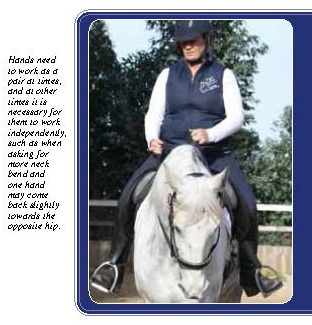
It is important to remember that the hands do not steer the horse as one might imagine, as they are not attached to a steering wheel! The hands ask the horse to bend its neck and follow the bend in that direction. If turning to the left for example, a ‘direct rein’ that asks the horse to turn in that direction is used. This is done by moving the left hand back slightly towards the body and asking the horse to bend its neck. The rider should take care not to drop the hand down as this will mean that the horse will drop the inside shoulder and swing the hindquarters out of the circle. A correctly used direct rein supports the inside front leg and prevents the shoulders from falling in or out of the circle and the hindquarters from falling in.
Once the horse is moving forward on the circle with the correct bend and rhythm the inside rein should be softened slightly as a reward to the horse for having done the right thing. The rider should not keep holding the rein back slightly as, if the hand keeps asking and hanging on without any relief for the horse from the pressure or the cue, it will teach it to be resistant to the hand and to hang onto the bit. If the horse is a little dull to begin with and reluctant to bend the neck the rider can either (a) move the bit a little in the horse’s mouth, as if milking the reins, whilst supporting the horse with a little inside leg or (b) raise the hand a little and move it towards the rider’s opposite hip to increase the bend – if doing this it is important to ensure that the hand does not cross over the horse’s wither. The rider must also be careful not to tip the horse’s head too much as this can become a habit and gives the illusion the horse is bending its neck and flexing, when in actual fact it is just tilting its head or its neck in the direction towards the inside of the circle.
When riding a young or ‘green horse’ the cues may need to be more obvious and this is when riders can sometimes be seen opening up the inside rein away from the horse’s neck whilst maintaining the outside rein contact.
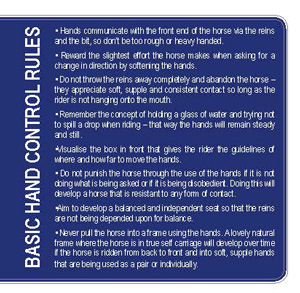 THE OUTSIDE REIN THE OUTSIDE REIN
The outside rein regulates the amount of bend - on the circle - that the inside hand has asked for and becomes the ‘indirect rein’. The indirect rein regulates the speed, the straightness and any problems that may arise through the neck, shoulders and hindquarters. The indirect rein is also used for lateral movements such as leg yield, half pass, travers, renvers etc. It is responsible for the movement and control of the outside shoulder and hind leg; is used to prevent the hindquarters from falling in on the circle; determines the amount of bend through the neck, the size of the circle and the position of the head.
Hand position and control is often very misunderstood but can be achieved with basic rules and the use of the hands in combination with the legs, collection, impulsion, rhythm and speed.
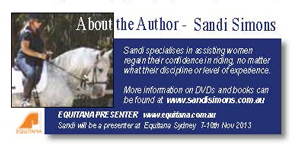
|